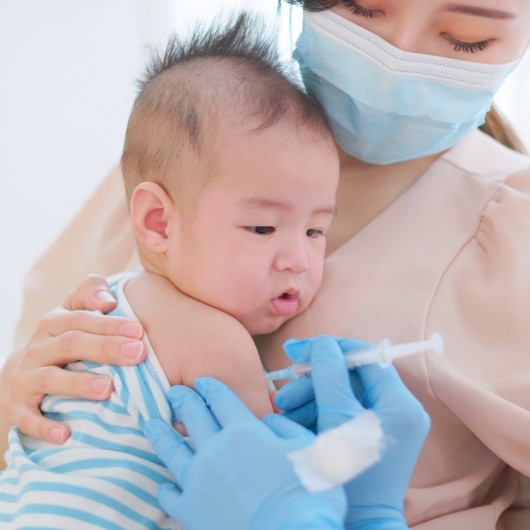Building Early Protection Through Vaccination

As a parent, one of the most important things you can do to safeguard your child’s health is to ensure they are protected against dangerous infectious diseases from an early age. In Singapore, the National Childhood Immunisation Schedule (NCIS) recommends the 6-in-1 vaccine as the standard option, administered during infancy (as early as 2 months). This combination not only reduces the number of injections your child needs, it also helps build strong immunity during their most vulnerable months.
Let’s take a closer look at how these vaccines work and why they play such a vital role in early childhood protection.
Understanding the 5-in-1 and 6-in-1 Vaccines
Both the vaccines are combination shots that protect against multiple diseases in one go:
- Diphtheria (D),
- Tetanus (T),
- Pertussis (aP, also known as Whooping Cough or 100-day cough),
- Inactivated Polio Vaccine (IPV), and
- Haemophilus Influenzae Type B (Hib)
And for the 6-in-1 vaccine, it includes all in the 5-in-1, plus
- Hepatitis B (HepB)
These vaccines are also referred to by their clinical names: DTaP-IPV-Hib for the 5-in-1, and DTaP-IPV-Hib-HepB for the 6-in-1 vaccine, based on the components they include. While the 6-in-1 vaccine is the standard under the NCIS, the 5-in-1 vaccine may be used in catch-up cases or if your child has already received Hepatitis B separately.
Understanding what this vaccine protects against can help parents and caregivers make informed choices and recognise the true value of early immunisation.

What Diseases Does This Vaccine Protect Against?
The vaccine is designed to provide protection against multiple diseases in a single vaccine (within 3 doses), reducing the number of injections your child needs.
The diseases targeted by these vaccines tend to affect infants and young children and can lead to serious complications. Administering them together is safe, effective and helps streamline early protection during your child’s most vulnerable years.
Here’s a breakdown of each disease, including how it spreads, its symptoms, and the potential health risks:
| Diphtheria | What it is: A serious bacterial infection that affects the throat and airways. How it's contracted: Spread through respiratory droplets from coughing or sneezing. Diphtheria Symptoms: Sore throat, fever, swollen glands, and difficulty breathing. How it affects: Can cause airway obstruction, heart damage, and death if untreated. |
| Tetanus | What it is: A bacterial infection caused by a toxin affecting the nervous system. Tetanus is not contagious and does not spread person to person. How it's contracted: Enters the body through cuts or puncture wounds, especially from contaminated surfaces. Tetanus Symptoms: Muscle stiffness, jaw lock (lockjaw), spasms, and fever. How it affects: Can result in breathing difficulties, severe spasms, and fatal complications. |
| Pertussis (Whooping Cough) | What it is: A highly contagious respiratory disease also known as the 100-day cough. How it's contracted: Spread via droplets from coughing or sneezing. “Whooping Cough” Symptoms: Severe coughing fits, vomiting, and a high-pitched “whoop” sound. How it affects: May cause pneumonia, seizures, and brain damage, particularly in infants. |
| Polio | What it is: A viral infection that can affect the nervous system. How it's contracted: Primarily through contaminated food, water, or faeces. Polio Symptoms: Fever, fatigue, headache, neck stiffness, and limb weakness. How it affects: Most polio infections are asymptomatic, but in rare cases, it can lead to paralysis or death. |
| Haemophilus influenzae type B (Hib) | What it is: A bacterial infection that can cause serious illness in children under five. How it's contracted: Spread through respiratory droplets or close contact. Hib Symptoms: Fever, cough, breathing difficulty. How it affects: Can lead to meningitis, pneumonia, and other severe complications. |
The 6-in-1 vaccine includes all the above vaccines plus Hepatitis B:
| Hepatitis B | What it is: A viral infection that affects the liver. How it's contracted: Passed from mother to child at birth, contact with open wounds, or sharing personal items with infected blood. Symptoms: Fatigue, jaundice, abdominal pain, dark urine. How it affects: Can cause chronic liver disease, cirrhosis, or liver cancer. |
Now that we’ve covered the diseases these vaccines protect against, let’s take a look at when your child should receive them for the best possible protection.
When & How Often Should You Get Vaccinated?
As a parent, your child’s health and safety are always a top priority, especially in their early years when their immune systems are still developing. One of the most effective ways to protect your little one from serious and potentially life-threatening diseases is through timely childhood vaccinations.
Vaccine Schedule:
Vaccination schedules help ensure your child builds immunity at the right stages of development. In Singapore, the 6-in-1 vaccine is part of the recommended NCIS timeline and is typically given in three doses:
- 1st dose at 2 months
- 2nd dose at 4 months
- 3rd dose at 6 months
Note: Although the 6-in-1 vaccine includes Hepatitis B, a separate dose is usually given at birth before the combined series begins.
For Adults and Older Children: Ask About Tdap Boosters
While DTaP is part of your child’s routine vaccination schedule, older children and adults may require Tdap boosters to maintain protection against diphtheria, tetanus, and pertussis.
| Vaccine | Target Age Group | Purpose |
|---|---|---|
| DTaP | Infants and young children | Primary vaccination (in 5-in-1/6-in-1) |
| Tdap | Older children & adults | Booster to maintain immunity |
If you're unsure of your last dose, consult your doctor for clarification.
What to Expect During & After the Vaccination
Knowing what happens during the appointment can help ease any concerns you may have as a parent. Getting your child vaccinated is usually a quick and straightforward process, but as a parent, it helps to be prepared.
Before the appointment, ensure your child is well-rested and has had a light meal. Bring along their health booklet, and dress them in clothing that allows easy access to the upper thigh or upper arm for the injection.
During the vaccination, your child may feel a little discomfort, but this is very brief. Some common side effects to watch for afterwards include:
- Mild fever
- Redness, swelling, or soreness at the injection site
- Fussiness or irritability
- Temporary loss of appetite or sleepiness
These symptoms are usually mild and should clear up within a day or two. You can use a cool compress on the injection site or consult your doctor about giving paracetamol if needed. However, seek medical attention if your child has a high fever, persistent crying lasting more than 3 hours, severe swelling, or any unusual behaviour.

Book Your Child’s Vaccination
Protect your little one from serious illnesses early. Schedule your child’s 5-in-1 or 6-in-1 vaccination at the nearest Healthway Medical clinic.
Book Your Vaccination
